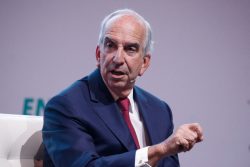Controversy and differing interpretations continue to follow Fidel Castro’s statement that “the Cuban model doesn’t even work for Cuba any more,” with experts trying hard to read the tea leaves in the still intensely closed political system of that country. The subsequent decision of President Raul Castro’s government to dismiss up to 10 per cent of the work force can be taken as an indication that Fidel’s words can be taken literally, and even as a signal to his decision-makers to go ahead with a change of strategy. Yet onlookers will probably hold their final opinions until it is possible to see whether the government is willing to take the related measures that will encourage the opening of channels for the growth of small and middle-level enterprises, along with the provision of resources to enable people who have been dependent on the state for such a long time, to accumulate the start-up capital that such activities require.
Some analysts might be tempted to believe that Fidel Castro’s quixotic statement could be compared to that of the Chinese leader Deng Tsiao Peng who, if we read history backwards, gave a signal for the introduction of the end of communist economic ideology in that country with his statement, “It doesn’t matter if the cat is black or white as long as it catches mice.” But Deng himself, in that then very closed society and political system, had been known to be wanting for some time to push through a change of policy in China. And he indeed took the risk of challenging those representing the status quo, suffering for some time the political price.
This is not the first time that there have been hints of a desire for change in Cuba in the years of the communist regime. Indeed, Raul Castro has announced changes in agriculture, but again with the same kind of tepidness characterizing the recent announcements. Observers are not as yet allowed to see a holistic picture of the kind that indicated the changes in China after 1979. Yet he does have a record of seeking substantial reform within the communist model, using the Cuban armed forces system as the framework for undertaking interventions in the tourism industry, for example. There, the state permitted the use of foreign investment to get that industry – in pre-Communist Cuba one of the main drivers of the economy – going again. And the country has attracted substantial investment in that area, including from Canada and Spain, which have had much more flexible approaches to the Cuban regime than the United States.
Some interpreters are tempted to see the recent moves toward limited reform as moving in parallel with moves lifting the embargo on the movement to Cuba of Cuban exiles and their families, as well as others in the United States. They see the moves as intended to encourage the Obama government to go further and widen the export of goods from the United States to Cuba beyond agricultural and some other commodities. But though it appears that Cuban-Americans have become much more acceptable of an American opening to Cuba, the President has not given signs of wanting to go too far in that direction for the time being. This may well be not unwelcome to the Cuban government which would want to exercise some degree of control over the pace of opening to its giant neighbour.
The Cuban government will have watched the attempt by both China and North Vietnam to introduce private sector and generally capitalist reforms into their systems, while still holding the reins of the political system fairly tightly under the communist political regime. But they will be aware too, that those states are far from the United States, and in that sense able to exert control over their borders to a much greater extent than a country so close to the US might be able to do under a regime of quasi-capitalist opening. Changes in policy on the use of the internet and cell phones suggest an understanding by the Cuban government that it will be necessary to bow to dynamic changes in technology inducing the extension of globalisation to all countries.
In that connection, the Cuban government will be well aware that as in China, the reform of the economy would require extensive investment in industrial infrastructure and equipment, acceptance of relatively free movement of capital, and an adjustment in the exchange rate of the Cuban peso to encourage competitiveness relative to other countries in the hemisphere.
We can assume also, even as it is still difficult to peer into the workings of the Cuban system, that within the island’s political elite, there is a fair amount of discussion on the geopolitics of the changes in the global system, including the increasing multipolarity in both economics and politics. Here the discussion will certainly turn on which of the so-called emerging powers, starting in Latin America itself, Cuba might be able to depend on for direction and assistance with economic reform. The first changes from its policy of dependence on the old Soviet system have come, for example, in innovative ways in which relations with President Chávez’s Venezuela can be transformed into financial returns. And there are signs that Brazil, with its extensive experience in deep-sea drilling is willing to involve itself, like Canada, in the search for oil and gas in Cuban territorial waters.
There are signs too, that Cuba is gradually responding to the insistence over the last few years by the European Union that it should end its widespread imprisonment of persons considering themselves human rights activists. This would be a quid pro quo for further European development assistance and investment in the island. The Cubans are aware that the Europeans now have extensive experience of the transformation the former Eastern European states of the world socialist system into liberalised open economies. But on the other hand it is unlikely that the EU states will want to force the Cubans to move in their liberalisation and institutional reform at the same pace as the Eastern European themselves willingly did, as the price of assistance to Cuba. A critical question for the Cubans will be, for example, the extent to which fiscal reform and liberalisation can take place without the virtual disappearance of the substantial social welfare system which the Cuban people have enjoyed. This is a critical question for the Chinese government as well.
Finally, it seems almost inevitable that over time, the Cubans will have to make a determination of whether and when it will become necessary to enter the main global economic organizations in today’s world. We refer in particular the World Trade Organisation, which now sets so many of the rules for global production and trade. That was a critical question for China, and it also determined the pace at which the United States sought to normalize relations with that country. It was a critical question nearer to Cuba. Mexico in the 1990s sought to modernise its own economic system, join the US and Canada in NAFTA, and with that, end the single-party political regime that it had maintained since its own 1910 Revolution.
In the last analysis it is probably the country’s proximity to the United States that will be the determining element in much of what transpires. But the extent to which Cuba’s hemispheric neighbours and the international aid institutions, are willing to assist its reform, particularly in maintaining the gains in education and health that all now agree are critical to continuing economic modernization, will determine whether the old regime insists on persisting, or finds a peaceful path of evolution.








